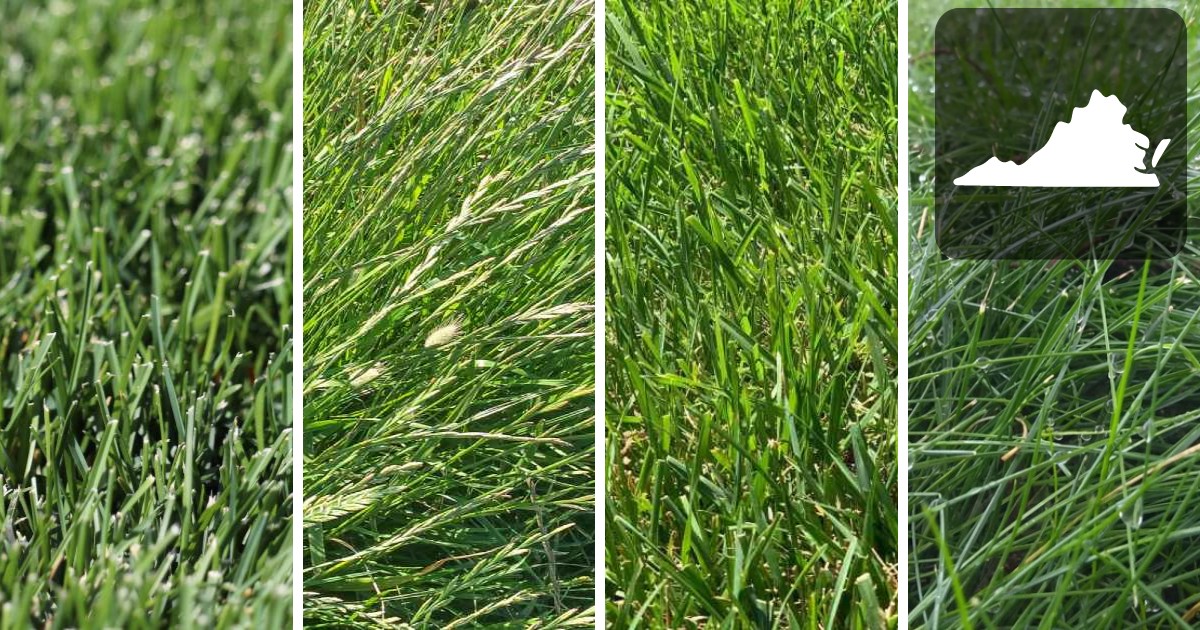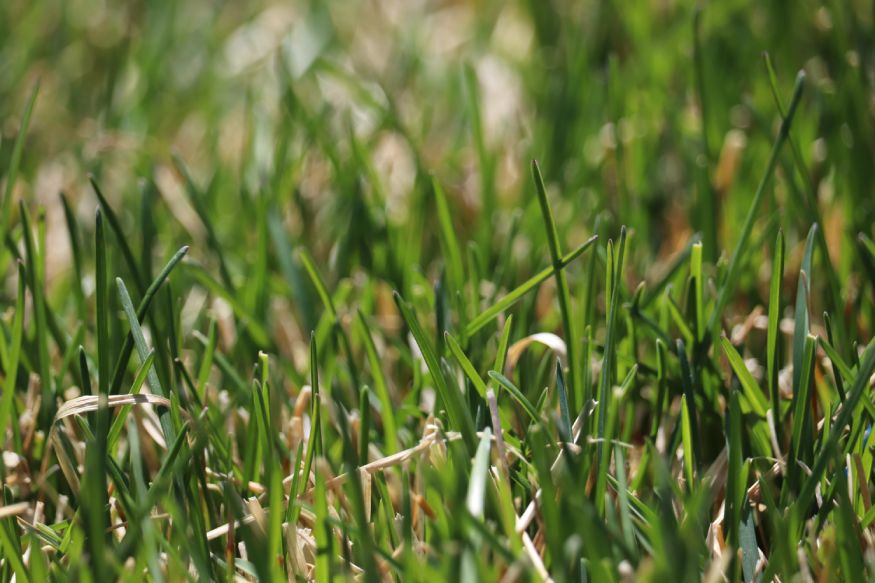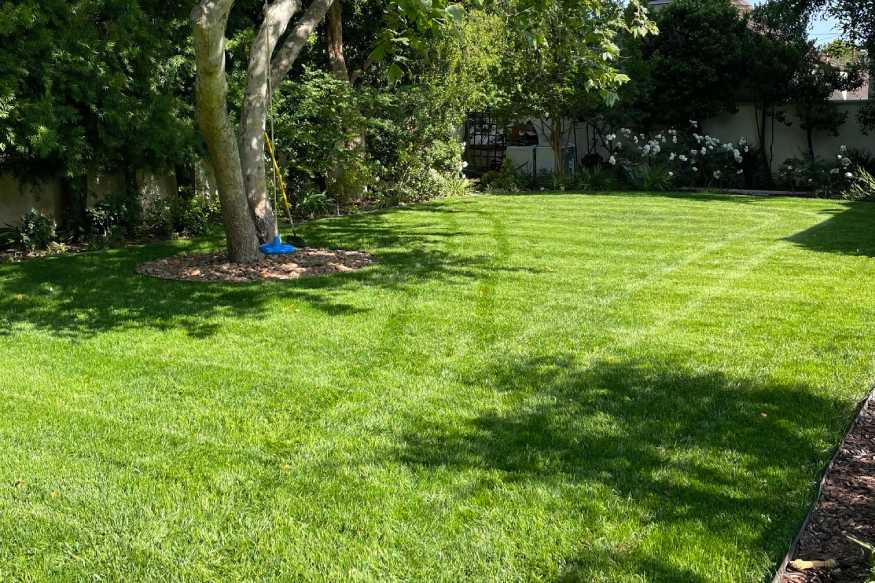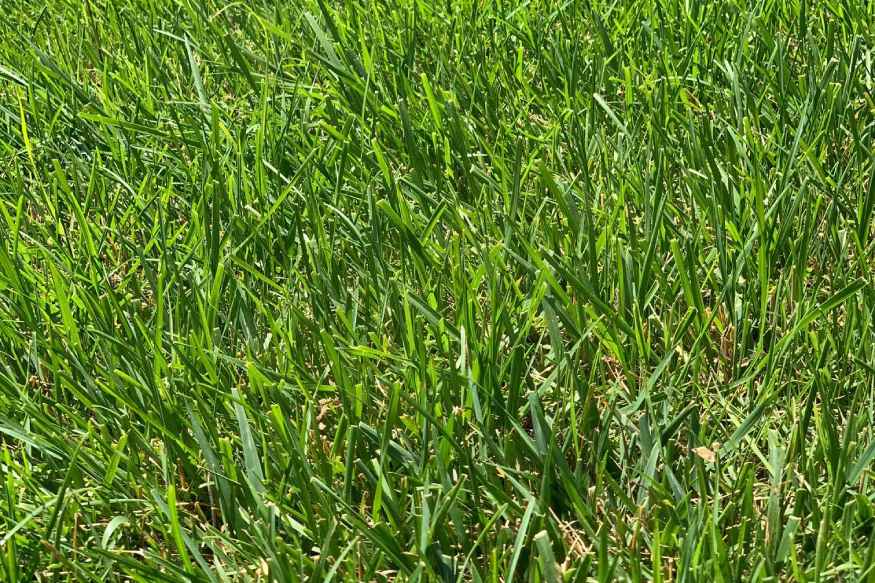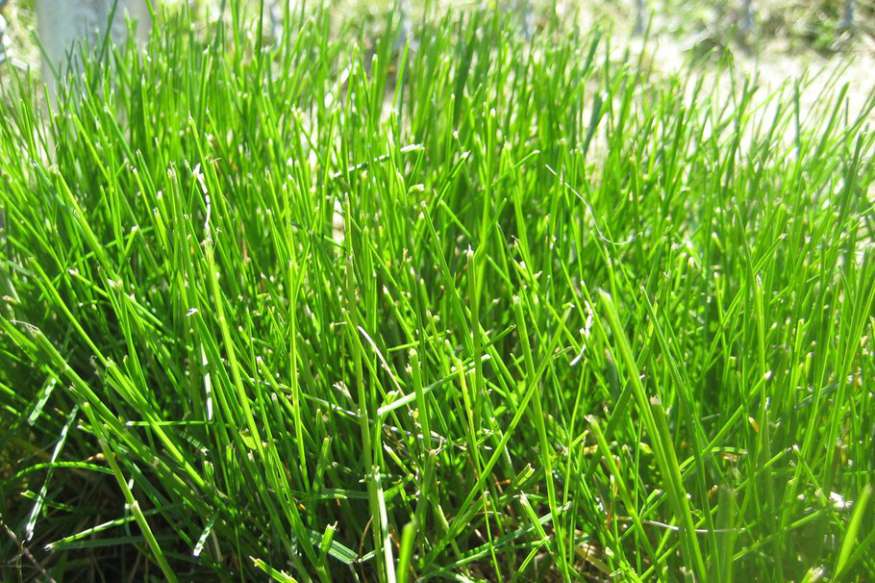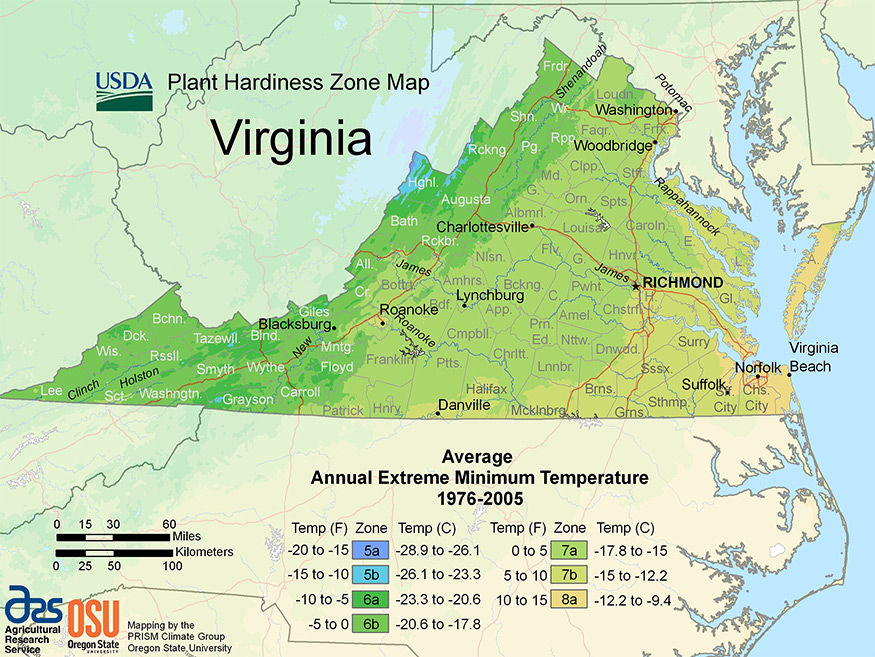With Virginia’s unique climate and soil conditions, it can be challenging to find the right grass seed for a thriving lawn.
Kentucky Bluegrass is a fantastic option that is well-adapted to the state’s conditions, but there are other options to consider as well, depending on your specific needs and preferences.
In this article, we’ll explore the best grass seed options for growing a lawn in Virginia, including the benefits and drawbacks of each. We’ll also go over the challenges faced by homeowners in Virginia when it comes to lawn care, such as extreme temperatures, heavy rainfall, and soil acidity.
By the end, you’ll have all the information you need to make an informed decision and achieve a lush, healthy lawn in Virginia.
Kentucky Bluegrass
| Also Known As | Poa pratensis L. |
| Type of Grass | Cool season perennial |
| Optimal Zones | Northern cool season zone, transition zones |
| Root Structure | Shallow |
| Winter hardiness | Excellent |
| Shade tolerance | Poor to Good |
| Water Requirements | High |
| Drought Tolerance | Poor |
| Self Repair Capacity | Excellent |
| Overall Maintenance Requirements | High |
Why Kentucky Bluegrass is a Good Choice For Virginia
Kentucky bluegrass is a popular choice for many homeowners, institutions, parks, and athletic fields. With its fine to medium texture and dark green color, it is one of the most attractive species of cool-season turfgrasses.
This grass produces underground stems, called rhizomes, that provide good sod-forming characteristics and superior recuperative potential compared to other cool-season turfgrasses.
Kentucky bluegrass is cold-tolerant, wear-tolerant, and moderately heat and drought tolerant. It is best suited for full sun, and moderate to high maintenance is required to keep it looking its best.
Although Kentucky bluegrass is a beautiful choice for Virginia lawns, it is relatively sensitive to poor soil and is susceptible to diseases such as dollar spot, red thread, and rust. This grass also has an aggressive creeping growth habit, which can lead to a significant thatch buildup over time.
Kentucky bluegrass can take up to 21 days to germinate and requires months to establish, making fall planting more successful than spring planting.
New releases of hybrid bluegrass, a cross of Kentucky and Texas bluegrass, show better heat and drought tolerance and are suitable for the warmer, drier regions of Virginia. While Kentucky bluegrass sod is not as widely available as tall fescue sod, it is still an excellent choice for those looking for a beautiful and high-quality lawn.
Perennial Ryegrass
| Also Known As | Lolium perenne L. |
| Type of Grass | Cool season perennial |
| Optimal Zones | Mild northern zones |
| Root Structure | Deep |
| Winter hardiness | Good to excellent |
| Shade tolerance | Moderate |
| Water Requirements | High |
| Drought Tolerance | Good |
| Self Repair Capacity | Excellent wear tolerance |
| Overall Maintenance Requirements | Moderate to high |
Why Perennial Reygrasss is a Good Choice For Virginia
Perennial ryegrass, a fine to medium-textured turfgrass, is gaining popularity in Virginia. While it lost its favor in the 1990s due to gray leaf spot disease, it has since regained its status thanks to turf breeders who have selected for improved resistance.
It’s a bunch-type grass with a dark-green color and has excellent wear tolerance. It’s ideal for full sun to moderately shaded lawns at elevations above 1500 feet. It’s also one of the fastest cool-season grasses to germinate and establish a dense canopy. Perennial ryegrass is often used for overseeding thin or damaged turf because of its aggressive nature.
This grass is suitable for use alone or in combination with Kentucky bluegrass and/or fine fescues. It can be mowed at low heights, typically between 1.5 to 2.5 inches.
One of the most appealing features of perennial ryegrass is its striping potential when it’s mowed. Additionally, it’s a great option for overseeding Bermudagrass lawns to maintain green color year-round. However, its drought tolerance is low, and it is typically dormant in summer. It also tends to have a high potential for disease, especially during warmer times of the year.
Overall, perennial ryegrass is a great choice for those who want to maintain a green lawn year-round and are willing to commit to regular mowing and overseeding.
Tall Fescue
| Also Known As | Lolium arundinaceum (formerly Festuca arundinacea) |
| Type of Grass | Cool season perennial |
| Optimal Zones | Northern through transition zones |
| Root Structure | Deep |
| Winter hardiness | Excellent |
| Shade tolerance | High |
| Water Requirements | Medium to High |
| Drought Tolerance | Excellent |
| Self Repair Capacity | Limited |
| Overall Maintenance Requirements | Low |
Why Tall Fescue is a Good Choice For Virginia
Tall fescue is a widely used, low maintenance grass that can withstand Virginia’s diverse weather and soil conditions.
This species has over 100 cultivars and is selected for finer texture, higher plant density, and a darker-green color than its earlier, coarser varieties. While it can be objectionable in a mixture with fine-textured turfgrass species, tall fescue is a great choice for homeowners looking for a low- to moderate-maintenance lawn.
Tall fescue is primarily a bunch-type grass that occasionally produces short rhizomes. Its root system is deep and extensive, allowing the plant to avoid drought by drawing water from deeper soil levels.
It performs best in open, sunny areas and is moderately shade tolerant. It is less suited to heavily shaded conditions than the fine fescues, but is more tolerant than Kentucky bluegrass and perennial ryegrass.
The seed germination period for tall fescue is 10-14 days, and it is readily available as sod across the state.
While tall fescue has a moderate tolerance to drought, it is still considered the hardiest and best-adapted grass in Virginia. However, it can struggle with extreme summer temperatures in the southern Piedmont and Tidewater regions. Despite this, tall fescue is still the most common grass in the state.
If you’re a homeowner looking for a lawn that doesn’t require too much maintenance, tall fescue might be the right choice for you.
Fine Fescues
| Also Known As | Hard fescue, strong creeping red fescue, slender creeping red fescue, sheep fescue, chewings fescue; Festuca L. |
| Type of Grass | Cool season perennial |
| Optimal Zones | Northern zones |
| Root Structure | Medium |
| Winter hardiness | Excellent |
| Shade tolerance | Excellent |
| Water Requirements | Medium to High |
| Drought Tolerance | Excellent |
| Self Repair Capacity | Limited |
| Overall Maintenance Requirements | Low |
Why Fine Fescue is a Good Choice For Virginia
The fine fescues, which consist of narrow-leaved species in the Festuca genus, are ideal for low maintenance lawns, particularly in the Valley, Ridge, and northern Piedmont regions of Virginia.
Composed of creeping red fescue, Chewings fescue, hard fescue, and sheep fescue, these grasses are under-utilized despite their high quality and persistent nature in dry conditions and somewhat poor soils.
While fine fescues have the best shade tolerance of cool-season turfgrasses, they don’t fare well in persistently wet soils and have poor traffic tolerance, making them unsuitable for areas with heavy foot traffic.
Fine fescues have a needle-like leaf texture that some homeowners may love, while others may find it unappealing. However, they produce an attractive and uniform stand with medium to dark-green color when maintained properly.
Seed is readily available, and while the grasses are slow to establish, they germinate quickly within 10-14 days. Fall is the best time to seed, and it’s recommended to use only 1 to 2 lbs of nitrogen per 1,000 sq ft per year to prevent over-fertilization.
Seed mixtures with Kentucky bluegrass are commonly sold as “sun-shade” mixes, where bluegrass dominates in the sun and fine fescue thrives in the shade. While fine fescue has the best chance of persisting in moderate shade, the grasses may segregate out over time.
Virginias’s Climate And Growing Challenges For a Healthy Lawn
Virginia is located in the southeastern region of the United States and has a humid subtropical climate. The state has four distinct seasons with hot and humid summers and mild winters. The climate in Virginia can be challenging for growing lawns due to its varying weather conditions and soil types.
Soil Conditions
Soil types vary greatly throughout Virginia, with the majority being clay-based. This can make it difficult for lawns to establish root systems and can lead to soil compaction. To combat these issues, homeowners should consider aeration and topdressing with compost or other organic matter to improve soil structure and nutrient content.
Soil acidity is another important consideration when it comes to growing a lawn in Virginia. Soil pH is a measure of soil acidity or alkalinity, with a pH of 7.0 considered neutral. Most cool-season turfgrasses, including Kentucky bluegrass, perennial ryegrass, and tall fescue, prefer a slightly acidic soil pH between 6.0 and 7.0. However, fine fescues are more tolerant of low soil pH, preferring a range between 5.0 and 6.0.
In Virginia, the soils tend to be naturally acidic due to the presence of organic matter and the leaching of basic minerals such as calcium and magnesium. Soil pH’s of 4.5 – 6.0 are common in many areas. This means that many lawns may require regular applications of lime to maintain an optimal soil pH for turfgrass growth.
It is important to test your soil pH regularly to ensure it is within the optimal range for your chosen grass species. Soil test kits are readily available from many garden centers. By understanding the soil acidity levels in your lawn, you can take steps to correct any imbalances and ensure your lawn has the nutrients it needs to thrive.
Weather
The weather in Virginia can be unpredictable, with frequent rainstorms and occasional droughts. This can lead to flooding and erosion in some areas, as well as drought stress on lawns in others. It is important to choose a grass species that can tolerate these varying weather conditions and to maintain proper watering practices to avoid damage to the lawn.
Growing Challenges
In addition to weather and soil challenges, Virginia lawns may also face challenges from pests and diseases. Common issues include brown patch, which is a fungal disease that thrives in humid conditions, and grub worms, which can damage the roots of grass. To combat these issues, homeowners should consider proper lawn maintenance practices such as regular mowing, fertilization, and overseeding to promote a healthy and resilient lawn.
Overall, the key to maintaining a healthy lawn in Virginia is to choose the right grass species, properly prepare and maintain the soil, and to stay vigilant against common pests and diseases.
